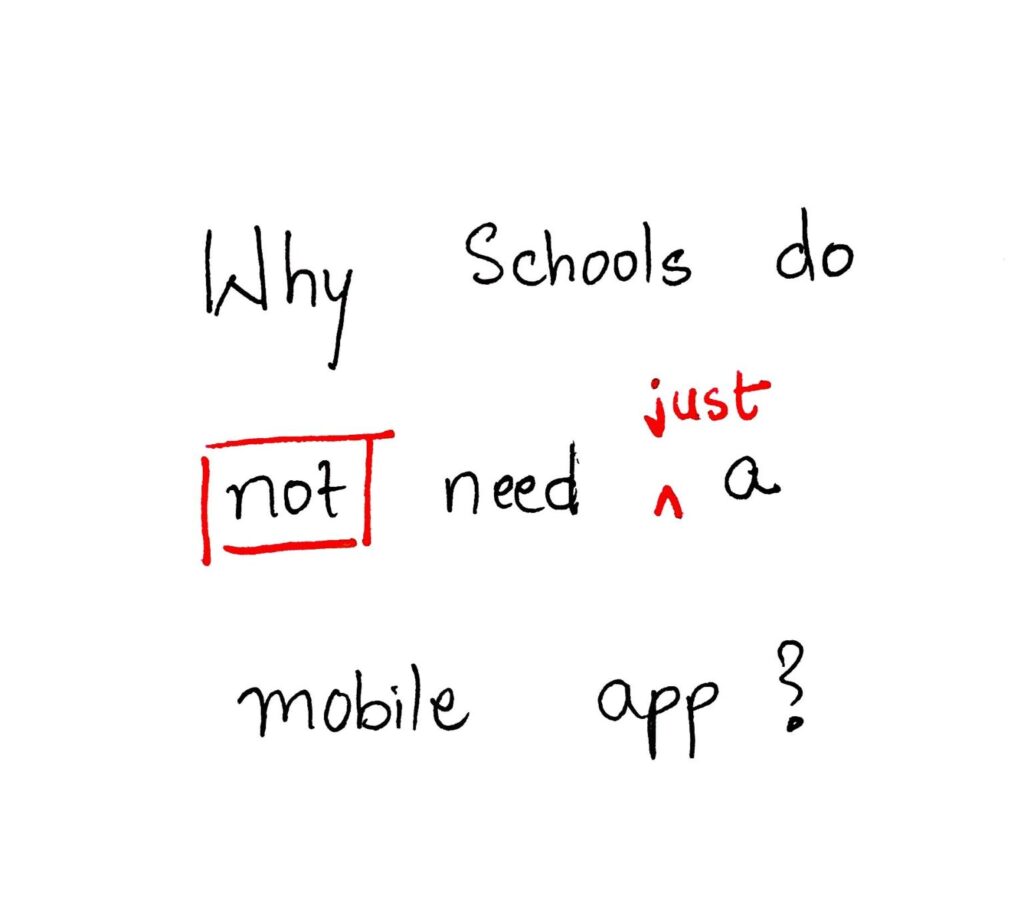Before we try to increase sales; “let’s take a deeper understanding of buyers and users for the app.”.
Do Parents want to have a mobile application to communicate with teachers?
The answer is a big Yes. (As validated by talking to a lot of parents. Parents who have the app are really happy, their only concern is certain missing features. Parents who do not have a mobile app to communicate with teachers want to have one.) While speaking to parents I noted down the list of features they absolutely love. Here is it for your reference:
- Most of the parents said they love to see their child’s pictures and videos.
- Parents are relieved that the app updates them about class notes, homework, project work, study material, state or national level competitions, concept testing etc.
- Parents feel that it’s wonderful that the school app provide GPS tracking system for their child’s school bus.
- One of the parents told that school developed an app based on feedback from parents. The app is live with minimalistic features and gradual extensions.
- One of the parents told that their school app has an e-wallet system. So, if the child wants to eat something from canteen, he/she can swipe his/her Id card where we deposit certain amount of money. Parents receive each & every detail of what the child ate, how much did it cost etc. on the app.
Does School need a mobile application to communicate with parents? #FoodForThought
Are apps solving any problems for school? Is app going to bring them more business? The honest answer is NO.
The app definitely addresses pain points faced by Parents. The app makes it easier for parents to communicate with the teacher. Parents can access class-notes, check child’s progress, respond to school circulars, track location of their child’s school bus.
Then, why would school buy the app?
(Please do write your answer to this question in the comment section.)
The point to be noted here is the user of the app is “Parent”, however buyer of the app is “School”.
So, in order for school to invest in the app and thus increase the sales of your school mobile app let’s do some brainstorming.
Who is your buyer?
How is their buying process?
What are different stages in buying process?
What’s your strategy to address the buyer in different stages of buying process?
Answering these questions can help you a great deal in designing your sales and marketing strategies. Thus, helping you to increase your sales.
Who is your buyer?

Is saying schools enough? Or can we further define it better?
- Preschools (Day Care Centers), Primary Schools or High Schools.
- Private or government schools.
- School fee and number of students.
- Demography of students.
- Technology oriented school or traditional school.
Finding these attributes about a school will help you estimate the likelihood of their interest in your app.
Now, in case of school mobile app there are three stake holders:

Let’s take a look at the mobile app from each one’s perspective.
- Parents: Let’s divide the parents in two groups based on the age of their children.
- Parents of Preschoolers or kindergartners who send their children to day care centers. On average children spend 8-10 hours of their day at the center.
- Did my child eat well?
- Did my child sleep well?
- How was my child’s day at school?
- Was my child taken for an outdoor play?
- Did my child have a bowel moment at school?
- Is my child able to mingle well with the peers and teachers?
- Parents of children in the age range of 6-10 years feel anxious about how their children (especially preschoolers and kids under 10 years of age) are doing at school in many ways:
- Is my child attentive in class?
- Does he understand the concepts well?
- How did he perform in his show and tell today?
- My child’s writing speed is slow. His notes are often incomplete and 80% of the times he doesn’t write the home-work details in diary. Wish the teacher updated this on daily basis somewhere.
- One more Parents Teacher Meeting means wasting 3 hours in commute, waiting for my turn to meet the teacher. Wish this could be completed in a 15 minutes video call.
- Oops! I missed to fill the field trip consent form. Wish I could just give my consent on the mobile app with a single click.
- Parents with children above 10 years of age are not so anxious. As Children above 10 years of age can clearly communicate about anything happening at school.
- However, they can benefit from updates on class notes, assignments, circulars etc. through the app.
- Parents of Preschoolers or kindergartners who send their children to day care centers. On average children spend 8-10 hours of their day at the center.
#FoodForThought: So why would schools invest in the mobile app? Alternatively, Parents can pay for the app, School can just facilitate it. What do you think?
Let’s say a school has 11000 children studying in its different branches across the city. And the school invests 13 lac INR to develop the app. Each parent gets to download and use the app for a one-time cost of 300 INR. Now let’s do some math. 300 x 11000 = 3300000 = 33 lac INR. Thus, recovering their investment as well as keeping the surplus for app maintenance or updates in later times.
- Teachers & Admin Staff:
- Teachers feel that admin work like updating child’s portfolios takes up too much of time. Imagine the traditional way of creating children portfolios. Selecting pictures, printing them, cutting them, pasting them, writing the child’s progress across various parameters. Versus. Uploading pictures at a click of a button. Giving objective feedback through radio buttons. Or using intuitive writing provided by the app for detailed progress report.
- One of the staff’s responsibility is to do temperature scan for each student of the school. Also, to record it along with attendance logs. If there were a Bluetooth enabled thermometer, integrated with your mobile app, which would directly create temperature logs. It would save many staff hours.
#FoodForThought: Let’s say school wants to send out field trip circular with a consent form to all the parents. There are 500 students. The staff will have to print and get these 500 papers and get it distributed to each and every student. Students take those circulars to their parents. Parents respond to it next day. All the circulars are collected. And based on the consent staff chalks out further details. Now look what can digitization do to it. Staff shares the circular over mobile app with parents. Parents give their consent with a single click of button on mobile itself. App then generates a report on how many student’s parents said a yes in no time. This saves paper and time both.
- Schools: Let’s find out WHY at all should schools have mobile apps? If our answer to WHY is convincing enough. If the school also believes in the same vision as app development company; it would be much easier for school to make a buying decision.
- To adapt the state-of-art practices
- The world is constantly changing. If the school does not keep up with the latest technology. Projecting itself as a technology-oriented school increases its brand value.
- To stop wasting too much paper
- Schools use paper for admission forms, consent forms, field trip announcements, circulars, worksheets, class notes, exam papers, feedback forms etc.
- Practice what you Preach! It’s the school, the teachers who teach students to save paper. But first they need to practice it themselves. And set an example by saving tons and tons of paper.
- To increase parental engagement
- Customer is the king. For a school, parents are the customers. If the mobile app makes parents happy; it’s worth it.
- Imagine having live sessions between parents and teachers like a video conferencing. Thus, saving commute time and fuel for parents. This reduces a 2-3 hours venture into 15 minutes.
- Parents feel delighted to see how their kids performed at the show and tell or delivered a speech in school.
- To adapt the state-of-art practices
How is their buying process going to look like?
There would be some triggers for a school to consider investing into a mobile app. For example:
- Competitor school is using a mobile app, maybe we should give a try too.
- Parents are insisting on having a mobile app to better communicate with teachers.
- Every business is benefitting from digitization, why not schools too.
- Some mobile app business owner approached the school.
Based on the triggers school will look for mobile app solutions. Compare different solutions and choose the one that they think is best suited for their school. Breaking down this buying process in various stages; where each stage is an action taken by the buyer in the process of buying; will help you decide the right course of response to that action.
What are different stages in buying process?

What’s your strategy to address the buyer in different stages of buying process?
(Stay tuned for an answer to this question in the part 2 of this article.)
I got an opportunity to speak to a few principals, school owners, people from school management, coordinators to get their take on mobile app.
This is the first response from owner and principal of the school with 5 branches in Indore, India.
“Hi Aditi! We have 5 branches of school, for senior school we use NIIT’s school management software. It also provides a mobile app to communicate with parents. For rest 4 branches we use teach next. Actually, we have invested in their smart boards for classroom. They also provide a mobile app for communicating with parents. Frankly, when we bought NIIT’s school management software, we made a one-time payment as agreed by both the parties. However, their backend support is pathetic. It’s like they are not going to get any more money from us. So why care? The software crashes many a times, it’s hard to get any of its features customized (e.g. progress reports). Earlier our data was on a physical server and not on a cloud. So, if there is a loss of electricity, we could not send homework to parents. With the advent of the app we went diary less (no more parent handbook) but we had a tough time educating the parents on usage of app. This challenge can be accounted to the demography of the parents. Most of them are not so tech savvy etc.”
#FoodForThought: Onetime payment with free services for long time may seem like a good deal to win the customer. But the chances are you/your team/your company loses motivation in providing a free service later for various reasons. Better not to have such a model.
#FoodForThought: Mobile App businesses are really competitive. Our wisdom says the returns on the kind of investment you put in an app business may not be glamorous. Better to offer something way beyond it.
One more interview with the owner and principal of a renowned school with 5000 students in India was like an eye-opener for me. And it surely is an eye opener for companies that provide School Management System or ERP (Educational Resource Planning) solutions for schools.
Me: “Hello Mam! Do use any School Management Software for your school?”
Principal: “Hi Aditi! Yes! We started with NIIT’s school management software. It had limited features, mainly dealing with fee and report cards. Then we switched to Academia. For Academia, we were the first client as a school. Before us they were working mainly with universities. They could not handle our requirements. Currently we are using MyClass. It’s best in three, affordable too, but still it’s not what I exactly want.”
Me: “What are your expectations from the School Management Software?”
Principal: “I have 5000 students and a team of 370 people working for the school including teachers, admin staff, IT staff etc. I want a tool that gives me complete information about every single student, parent, teacher, staff etc. at a click of the mouse.”
Me: “What is the kind of information you are looking at?”
Principal: “Consider this scenario Aditi, I have meeting scheduled with the parents whose child got a compartment in class 9th in Mathematics. Even before the parents enter my room, I want all the information about child’s performance throughout the year. Details of feedback sent to parents by teacher. Parent’s response to the feedback. Regularity in assignments. Attentiveness in class. medical issues, if any. With this information handy, it would be much easier for me to converse with the parents. Not just this, I wish to have complete demographic information about students and parents. How many doctors, politicians, businessmen etc. among parent?”
Me: “Do you also use a mobile app to communicate with the parents?”
Principal: “We do have an app (as a part of School Management Software) to communicate with parents. But it has its own challenges. For 5000 students there had been only 1000 downloads. So, we can’t rely on just one medium for communication. We use SMS (Short Messaging Service), emails as well as paper-based circulars along with mobile app. However gradually we want to have a single reliable mode of communication with parents.”
Me: “How much does it cost to have a School Management System?”
Principal: “Most of the vendors we talked to offered per student model of payment. So, let’s say if they charge 90 INR per student, it becomes 90 x 5000 = 450000 INR for us. Which is a huge amount to invest with subject to the demography of our students.”
Me: “Tell us Why did you start this school?”
Principal: We started the school with a vision to providing quality education to less privileged students at an affordable fee. And after years of turmoil, I can proudly say that we have done it for thousands of children and will continue to do so. It gives me immense happiness to see my children win gold and silver medals at national and international competitions.
Based on this interview, I have created a sample of buyer’s (Principal and Owner) journey (Buying Process). The buyer who is considering to invest in a school management system. Let’s read the buyer’s mind!
Here is the magnified view of each stage of buyer’s journey.
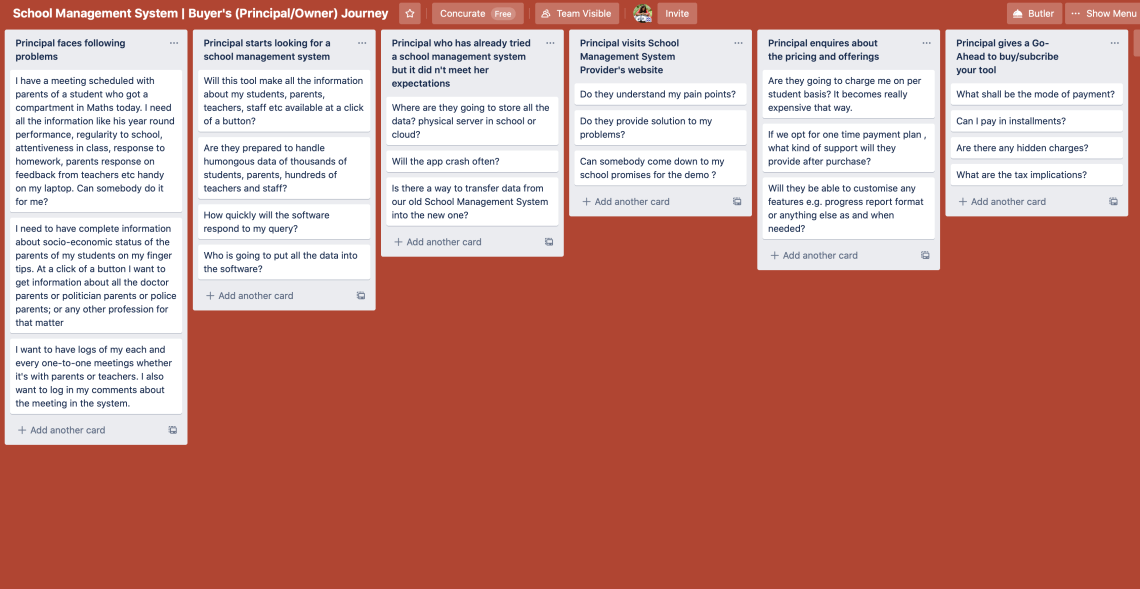
1.Principal faces following problems:
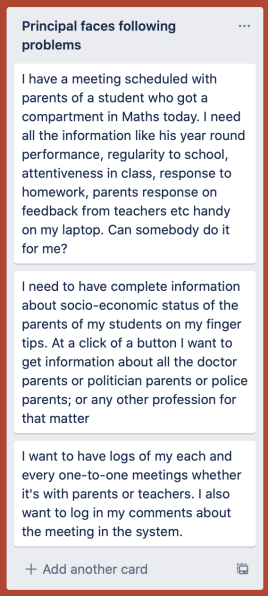
2. Queries in Principal’s mind who is going to try a School Management System for the first time.
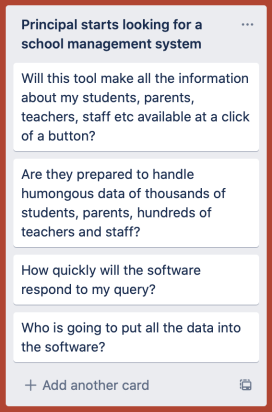
3. Queries in the Principal’s mind who has already used some School Management System.
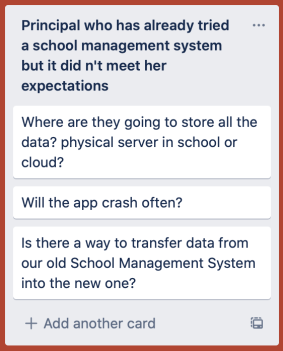
4. Principal visits the School Management System provider’s website.

5. Principal enquires about the pricing and the offerings.
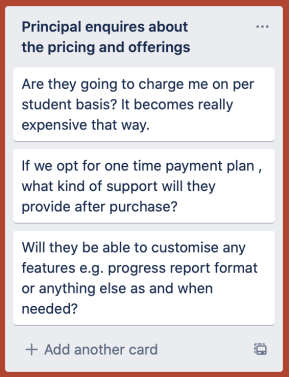
6. Principal gives a go-ahead to buy/subscribe your School Management System.
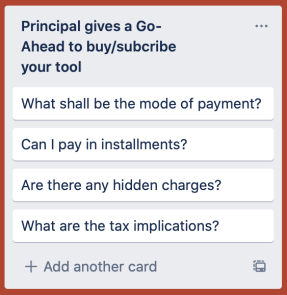
After reading buyer’s mind, if we redirect our sales and marketing initiatives, our likelihood of success increases exponentially.
How to do that will be shared in part 2 of this article.
Part 2 of the article will only be sent exclusively over email to interested parties.
In part 2 we are going to share lot more key-insights towards the business growth of School Management System Solutions company.
Pro tip: If you need 30 standout SaaS growth hacks to attain double the growth for your SaaS business, fill out the form below!
If you are interested in part 2, tell us how can we reach you!
If you enjoyed reading this article, we have more for you. This article shows how focussing on buyers can increase sales for you. Special thanks to David Skok for giving an absolutely wonderful framework to build a sales and marketing machine for a company.
If your organisation wants its content marketing strategy designed by Concurate, let’s connect over a short call. Block our calendar today!


